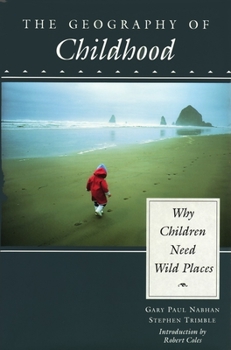The Geography of Childhood (The Concord Library)
Select Format
Select Condition 
Book Overview
In this unique collaboration, naturalists Gary Nabhan and Stephen Trimble investigate how children come to care deeply about the natural world. They ask searching questions about what may happen to children denied exposure to wild places - a reality for more children today than at any time in human history. The authors remember pivotal events in their own childhood that led each to a life-long relationship with the land: Nabhan's wanderings in the wasteland of steel mills and power plants of Gary, Indiana, and in the Indiana Dunes; Trimble's travels in the West with a geologist father. They tell stories of children learning about wild places and creatures in settings ranging from cities and suburbs to isolated Nevada sheep ranches to Native American communities in the Southwest and Mexico. The Geography of Childhood draws insights from fields as various as evolutionary biology, child psychology, education, and ethnography. The book urges adults to rethink our children's contact with nature. Smallchildren have less need for large-scale wilderness than for a garden, gully, or field to create a crucial tie to the natural world. Nabhan suggests that traditional wilderness-oriented rites of passage may help cure the alienation of adolescence: "Those who as adolescents fail to pass through such rites remain in an arrested state of immaturity for the remainder of their lives". Trimble's fatherhood leads him to question how we grant different freedoms to girls and boys in their exploration of nature - and how this bias powerfully affects adult lives. Both authors return to their experiences with indigenous peoples to show how nature is taught and wilderness understood in cultures historicallygrounded outside of America's cities and suburbs. The Geography of Childhood makes clear how human growth remains rooted, as it always has, both in childhood and in wild landscapes. It is an essential book for all parents and
Format:Paperback
Language:English
ISBN:0807085251
ISBN13:9780807085257
Release Date:April 1995
Publisher:Beacon Press
Length:208 Pages
Weight:0.78 lbs.
Dimensions:0.5" x 5.9" x 8.9"
Customer Reviews
4 ratings
Children Need Nature
Published by Thriftbooks.com User , 16 years ago
Nabhan and Trimble show us a world of wilderness that too often are denied our children. Discussing their own experiences as well as those of their children, they give the reader a great appreciation for nature and for childhood. As Nabhan puts it, "The playful exploration of habitat by cohorts of children... [has] been essential to child development for over a million years" (p. 83). An excellent book that has helped inspire my preschool center to add some natural elements to our playground.
Inspiring! Reinvigorating for parents
Published by Thriftbooks.com User , 16 years ago
The Geography of Childhood is a collection of essays that inspired me, as a parent, to slow down and enjoy the smaller and often ignored parts of childhood. I've caught myself on many occasions encouraging my child to "look at the view" and take in an entire landscape. This book reminded me to look at him as well, to watch him dig at the dirt or find a funny-shaped rock. "Learning Herps" was my favorite essay, I love the visual images it creates of children catching lizards and parents finding delightful surprises in the bathtub.
The landscape through a child's eyes
Published by Thriftbooks.com User , 25 years ago
Gary Nabhan and Stephen Trimble have penned a fine collection of essays on how children perceive and play in their environment. References are made to psychological studies that support a child's need for wild places, but the real value I see in this book comes from the authors' own anecdotal experiences with their children. If you are a parent of small children, you will especially enjoy the ideas you will get for places to take children to play and explore. Read this book and you will begin to learn why children need to experience wild places. And why, as adults, if we share the "hands-on" experiences with our kids, our own connection to the landscape becomes more deeply rooted.
I loved it!
Published by Thriftbooks.com User , 25 years ago
At first glance, this book seems to be another in a long line of published material telling parents how to be good parents. But it really seemed like a personal reflection of what makes life great through a child's eyes. Instead of trying to raise a child through adult methods, this book shows that through simply remembering what being a child was and why it was fun is enough to help you understand what your child is thinking. Through this understanding, you will become a great parent. I was very pleased with my purchase and recommend this book to anyone that has had any contact with children.





